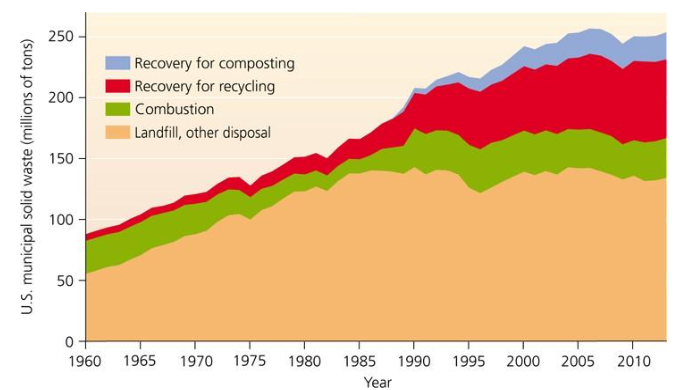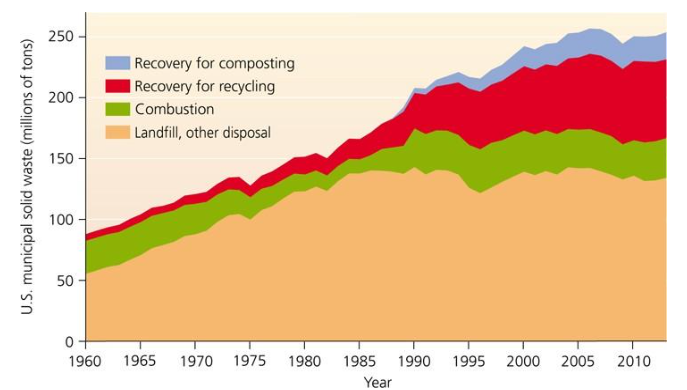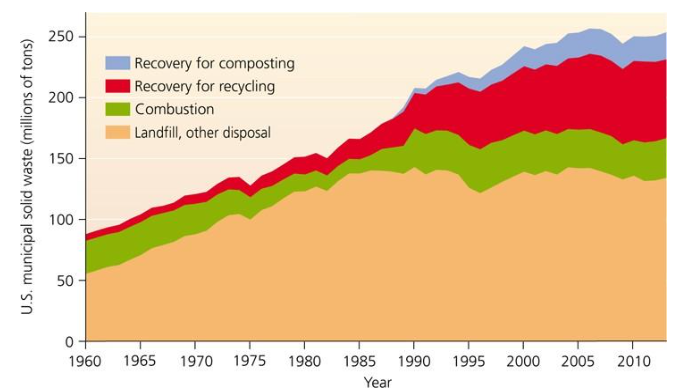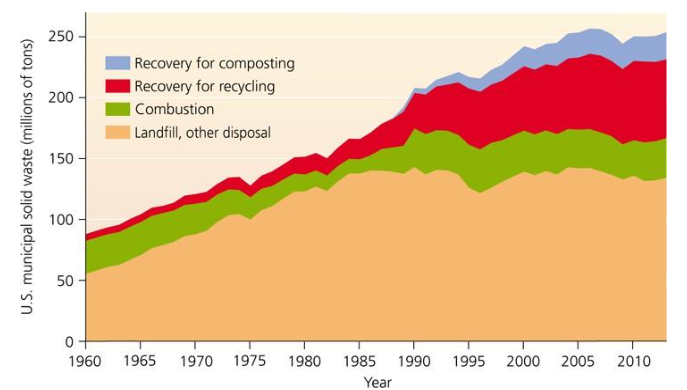ch 22: dadaism
1/36
There's no tags or description
Looks like no tags are added yet.
Name | Mastery | Learn | Test | Matching | Spaced |
|---|
No study sessions yet.
37 Terms

1) According to the figure, which of the following trends occurred from 1960 to 2000?
A) a decrease in the amount of waste produced
B) a decrease in the amount of waste sent to landfills
C) an increase in the amount of waste being recycled
D) a decrease in the amount of waste being combusted
E) an increase in the number of functioning landfills
C) an increase in the amount of waste being recycled

2) In which of the following years was the greatest volume of material recycled?
A) 1970
B) 1980
C) 1990
D) 2000
E) 2010
E) 2010

3) Which decade was associated with the greatest percentage increase in the amount of waste disposed of in landfills?
A) 1960s
B) 1970s
C) 1980s
D) 1990s
E) 2000s
A) 1960s

4) According to the figure, which of the following trends has occurred since 1990?
A) an increase in the amount of waste being composted
B) an increase in the amount of waste being landfilled
C) an increase in the amount of waste being combusted
D) a decrease in the amount of waste being recycled
E) a decrease in the amount of waste produced
A) an increase in the amount of waste being composted

5) In 2013, how many millions of tons of U.S. municipal solid waste were either recycled or composted?
A) 250
B) 160
C) 90
D) 130
E) 20
C) 90
1) In the U.S., which of the following produce(s) the largest amount of unregulated hazardous waste?
A) industry
B) households
C) agriculture
D) utilities
E) military
B) households
2) The average American generates approximately ________ lbs. of solid waste per day.
A) 40
B) 1.5
C) 4.4
D) 13.7
E) 9
C) 4.4
3) To safeguard against groundwater contamination, sanitary landfills are ________.
A) located on slopes so water runs downhill
B) lined with plastic and compacted clay
C) lined with cement
D) located in unpopulated areas
E) located on industrial sites where groundwater is not used for drinking or agriculture
B) lined with plastic and compacted clay
4) The amount of e-waste being produced in the U.S. is ________, and the amount of e-waste being recycled is ________.
A) increasing; increasing
B) decreasing; decreasing
C) increasing; decreasing
D) decreasing; increasing
E) increasing; leveling off
D) decreasing; increasing
5) The first bottle bills were ________.
A) designed to provide glass for road construction
B) initiated in the 1990s
C) designed to cut down on litter
D) designed to provide incentives to industry
E) a consequence of landfill regulations
C) designed to cut down on litter
6) The Fresh Kills Landfill ________.
A) collapsed onto a residential neighborhood because it had been filled to too great a height
B) will remain open until late 2020
C) is being converted into a public park
D) is a Superfund site located in Philadelphia
E) is New York's first and only modern sanitary landfill
C) is being converted into a public park
7) What do the town of Times Beach, Missouri, and the Love Canal neighborhood of Niagara Falls, New York, have in common?
A) Both recently won presidential recycling awards.
B) Both were evacuated because of contamination by toxins.
C) Both have banned the use of plastic grocery bags.
D) Both have municipal programs for dealing with e-waste.
E) Both were built on closed municipal landfills.
B) Both were evacuated because of contamination by toxins.
8) In the United States today, the approach that best reduces the volume and weight of municipal solid waste is ________.
A) compaction
B) composting
C) sanitary landfills
D) incineration
E) recycling
D) incineration
9) The Resource Conservation and Recovery Act is a U.S. law enacted in the 1970s that ________.
A) reduces environmental levels of the 12 most toxic chemicals, called the "dirty dozen"
B) requires states to pass bottle bills
C) requires states to enact strict recycling standards
D) regulates how hazardous waste is managed
E) restricts use of off-road vehicles in national parks
D) regulates how hazardous waste is managed
10) Which of the following is produced by anaerobic decomposition in landfills?
A) carbon dioxide
B) ozone
C) nitrogen oxides
D) methane
E) methylmercury
D) methane
11) Lining a landfill with a thick tough plastic barrier is a strategy to address problems related to ________.
A) methane production
B) settling
C) incomplete decomposition
D) leachate
E) mudslides and trash slides
D) leachate
12) Recycling aluminum cans saves ________ % of the energy needed to make the same amount of aluminum from virgin bauxite.
A) 95
B) 80
C) 70
D) 50
E) 25
A) 95
13) Over half of all U.S. MSW consists of ________.
A) toxic waste
B) plastics and metals
C) glass, rubber, and wood
D) paper, food waste, and yard waste
E) plastics, metals, and glass
D) paper, food waste, and yard waste
14) Industrial ecologists ________.
A) favor an economy that moves linearly rather than circularly
B) advocate taxes on green industries
C) redesign industrial systems to maximize physical and economic efficiency
D) urge an emphasis on internal manufacturing costs rather than external costs
E) primarily analyze industrial inputs
C) redesign industrial systems to maximize physical and economic efficiency
15) Life-cycle analysis ________.
A) is an environmental movement designed to reduce municipal traffic and encourage alternative forms of transport
B) defines how different organisms interact within ecosystems
C) examines the cycling of carbon in the environment
D) is the study of statistical changes in the human population
E) examines the life of a product to increase efficiency
E) examines the life of a product to increase efficiency
16) Which of the following represent the categories of hazardous waste?
A) inorganic and organic
B) ignitable, corrosive, reactive, and toxic
C) nonbiodegradable and biodegradable
D) municipal, industrial and agricultural
E) solid, liquid, and gaseous
B) ignitable, corrosive, reactive, and toxic
17) Heavy metals ________.
A) become less hazardous after incineration
B) become less hazardous over time as they degrade chemically
C) are unregulated by the U.S. government
D) bioaccumulate in animal tissues
E) are not harmful unless they are directly ingested
D) bioaccumulate in animal tissues
18) E-waste often leaches hazardous levels of which of the following metals?
A) gold
B) silver
C) lead
D) uranium
E) platinum
C) lead
19) ________ is/are the intercollegiate recycling competition that began in Ohio in 2001.
A) The Green Giant challenge
B) Go Green
C) Recyclemania
D) The Recycle-or-Die games
E) The 3R games
C) Recyclemania
20) E-wastes are a source of ________.
A) compostable organic compounds
B) ignitables
C) heavy metals
D) radioactive materials
E) acid corrosives
C) heavy metals
21) Decomposition in a landfill will happen faster if there is more ________.
A) sunlight
B) moisture
C) garbage
D) methane
E) natural gas
B) moisture
22) The Superfund, established to clean up hazardous waste sites in the United States, is a part of what legislation?
A) Resource Conservation and Recovery Act
B) The Comprehensive Environmental Response, Compensation, and Liability Act
C) Superfund Authority Act
D) Hazardous Waste Management Act
E) Superfund Management and Liability Act
B) The Comprehensive Environmental Response, Compensation, and Liability Act
23) Deep-well injection ________.
A) is a method of disposing of hazardous wastes in deep aquifers
B) is a pool of strong acids on the land surface used for breaking down e-waste
C) involves putting hazardous wastes into layers of porous rock deep beneath human water supplies
D) is the EPA-approved method of disposing of low-level radioactive wastes
E) has been banned as unsafe by the Dept. of the Interior
C) involves putting hazardous wastes into layers of porous rock deep beneath human water supplies
24) The EPA is charged with cleaning up brownfields, which are ________.
A) agricultural lands polluted by acid and heavy metals
B) urban areas contaminated by acid drainage from mining
C) lands whose reuse or development is complicated by the presence of hazardous materials
D) coastal seagrass beds damaged by industrial dumping
E) desert regions used for unsafe nuclear waste disposal
C) lands whose reuse or development is complicated by the presence of hazardous materials
25) ________ pay for the cleanup of Superfund sites.
A) Polluters and taxpayers
B) The EPA and the Department of the Interior
C) State and local governments
D) The Comprehensive Environmental Response, Compensation, and Liability (CERCLA) Act of 1980 and the EPA
E) U.S. and Canadian governments
A) Polluters and taxpayers
26) In regard to the current state of e-wastes in the U.S., ________.
A) only because of the actions of charitable organizations, the recycling rate is 5%
B) although the recycling of e-wastes has improved, 60% of e-wastes are still being landfilled and incinerated
C) because the EPA has classified e-wastes as toxic, more than 95% are being recycled
D) the recycling rate has dropped significantly between 1999 and 2010
E) by EPA mandate, all metals in electronics have been replaced by biodegradable materials
B) although the recycling of e-wastes has improved, 60% of e-wastes are still being landfilled and incinerated
27) In general, buying in bulk is environmentally friendly because it ________.
A) reduces packaging waste
B) recycles materials that would otherwise wind up in a landfill
C) encourages people to eat or use just a little bit more than smaller sizes
D) encourages people to eat less or use less of a product
E) allows consumers to save money by purchasing larger amounts of an item for less
A) reduces packaging waste
28) Bottle bills ________.
A) have been passed in all 50 states and Puerto Rico
B) have been passed in just over half of the states in the U.S.
C) usually involve consumers paying a nickel deposit on a beverage container
D) have not effectively increased recycling rates in states that have them
E) are fees paid by beverage companies in certain states
C) usually involve consumers paying a nickel deposit on a beverage container
A "throwaway mentality" and increased packaging have amplified the consumption of paper and plastic in our society. Disposable plates, cups, and utensils are convenient, sanitary, and inexpensive, and packaging preserves freshness, prevents breakage, protects against tampering, provides information to consumers, and allows shipment of products over long distances. However, paper and plastic do not degrade readily in sanitary landfills. Garbologist William Rathje found legible newspapers in landfills decades after disposal. Because trees used to make virgin paper and petrochemicals used to make plastics may soon become depleted, source reduction is the best solution to the waste dilemma. Denmark has banned the use of nonrefillable beverage containers, and McDonald's restaurants in Austria and Sweden have been using biodegradable, compostable cutlery. Recycling has value as well, as long as the recycling loop is closed and people purchase recycled items. Bottle bills and municipal curbside collection provide recycling incentives. Paper recycling is profitable if waste is properly sorted. All kinds of paper and cardboard are recyclable. Food and paperboard (non-corrugated thin coated board such as cereal boxes) can contaminate collections, however, reducing their value. After processing, paper and cardboard are used to make paper towels and paperboard for packaging cereal, shoes, and toys. Uncapped, washed, and flattened plastic is recycled into carpets, pillows, and new bottles. Although low-density polyethylene (LDPE), from which grocery bags are made, is the most widely used plastic, beverage bottle polyethylene terephthalate, or PET(E), and high-density polyethylene, or HDPE, are the most widely recycled plastics. Containers from toxic substances such as motor oil, pesticides, and solvents are not usually accepted with collected plastic because of contamination. Methods to reuse and recycle polystyrene are in development, although presently, Styrofoam is not collected with other plastics and is considered a contaminant as well.
1) Closing the recycling loop refers to ________.
A) avoiding contamination of plastic and paper collectables during sorting
B) finding ways to recycle all plastics, including polystyrene
C) covering landfills once they have outlived their usefulness and converting the sites to public parks
D) composting biodegradable plastic
E) purchasing items made from recycled materials
E) purchasing items made from recycled materials
A "throwaway mentality" and increased packaging have amplified the consumption of paper and plastic in our society. Disposable plates, cups, and utensils are convenient, sanitary, and inexpensive, and packaging preserves freshness, prevents breakage, protects against tampering, provides information to consumers, and allows shipment of products over long distances. However, paper and plastic do not degrade readily in sanitary landfills. Garbologist William Rathje found legible newspapers in landfills decades after disposal. Because trees used to make virgin paper and petrochemicals used to make plastics may soon become depleted, source reduction is the best solution to the waste dilemma. Denmark has banned the use of nonrefillable beverage containers, and McDonald's restaurants in Austria and Sweden have been using biodegradable, compostable cutlery. Recycling has value as well, as long as the recycling loop is closed and people purchase recycled items. Bottle bills and municipal curbside collection provide recycling incentives. Paper recycling is profitable if waste is properly sorted. All kinds of paper and cardboard are recyclable. Food and paperboard (non-corrugated thin coated board such as cereal boxes) can contaminate collections, however, reducing their value. After processing, paper and cardboard are used to make paper towels and paperboard for packaging cereal, shoes, and toys. Uncapped, washed, and flattened plastic is recycled into carpets, pillows, and new bottles. Although low-density polyethylene (LDPE), from which grocery bags are made, is the most widely used plastic, beverage bottle polyethylene terephthalate, or PET(E), and high-density polyethylene, or HDPE, are the most widely recycled plastics. Containers from toxic substances such as motor oil, pesticides, and solvents are not usually accepted with collected plastic because of contamination. Methods to reuse and recycle polystyrene are in development, although presently, Styrofoam is not collected with other plastics and is considered a contaminant as well.
2) Plastic ________.
A) containers from motor oil are recycled with beverage bottles to make new bottles
B) polystyrene is considered a plastic contaminant
C) not made from recyclables is made from renewable raw materials
D) from beverage containers is easily recyclable if uncapped, washed, and flattened
E) from grocery bags is labeled with recycling symbols #1 and #2
D) from beverage containers is easily recyclable if uncapped, washed, and flattened
A "throwaway mentality" and increased packaging have amplified the consumption of paper and plastic in our society. Disposable plates, cups, and utensils are convenient, sanitary, and inexpensive, and packaging preserves freshness, prevents breakage, protects against tampering, provides information to consumers, and allows shipment of products over long distances. However, paper and plastic do not degrade readily in sanitary landfills. Garbologist William Rathje found legible newspapers in landfills decades after disposal. Because trees used to make virgin paper and petrochemicals used to make plastics may soon become depleted, source reduction is the best solution to the waste dilemma. Denmark has banned the use of nonrefillable beverage containers, and McDonald's restaurants in Austria and Sweden have been using biodegradable, compostable cutlery. Recycling has value as well, as long as the recycling loop is closed and people purchase recycled items. Bottle bills and municipal curbside collection provide recycling incentives. Paper recycling is profitable if waste is properly sorted. All kinds of paper and cardboard are recyclable. Food and paperboard (non-corrugated thin coated board such as cereal boxes) can contaminate collections, however, reducing their value. After processing, paper and cardboard are used to make paper towels and paperboard for packaging cereal, shoes, and toys. Uncapped, washed, and flattened plastic is recycled into carpets, pillows, and new bottles. Although low-density polyethylene (LDPE), from which grocery bags are made, is the most widely used plastic, beverage bottle polyethylene terephthalate, or PET(E), and high-density polyethylene, or HDPE, are the most widely recycled plastics. Containers from toxic substances such as motor oil, pesticides, and solvents are not usually accepted with collected plastic because of contamination. Methods to reuse and recycle polystyrene are in development, although presently, Styrofoam is not collected with other plastics and is considered a contaminant as well.
3) ________ can contaminate wastepaper and decrease the value of collected paper and cardboard.
A) Corrugated cardboard boxes
B) Cereal boxes
C) Office papers
D) Newspapers
E) Paper shopping bags
B) Cereal boxes
A "throwaway mentality" and increased packaging have amplified the consumption of paper and plastic in our society. Disposable plates, cups, and utensils are convenient, sanitary, and inexpensive, and packaging preserves freshness, prevents breakage, protects against tampering, provides information to consumers, and allows shipment of products over long distances. However, paper and plastic do not degrade readily in sanitary landfills. Garbologist William Rathje found legible newspapers in landfills decades after disposal. Because trees used to make virgin paper and petrochemicals used to make plastics may soon become depleted, source reduction is the best solution to the waste dilemma. Denmark has banned the use of nonrefillable beverage containers, and McDonald's restaurants in Austria and Sweden have been using biodegradable, compostable cutlery. Recycling has value as well, as long as the recycling loop is closed and people purchase recycled items. Bottle bills and municipal curbside collection provide recycling incentives. Paper recycling is profitable if waste is properly sorted. All kinds of paper and cardboard are recyclable. Food and paperboard (non-corrugated thin coated board such as cereal boxes) can contaminate collections, however, reducing their value. After processing, paper and cardboard are used to make paper towels and paperboard for packaging cereal, shoes, and toys. Uncapped, washed, and flattened plastic is recycled into carpets, pillows, and new bottles. Although low-density polyethylene (LDPE), from which grocery bags are made, is the most widely used plastic, beverage bottle polyethylene terephthalate, or PET(E), and high-density polyethylene, or HDPE, are the most widely recycled plastics. Containers from toxic substances such as motor oil, pesticides, and solvents are not usually accepted with collected plastic because of contamination. Methods to reuse and recycle polystyrene are in development, although presently, Styrofoam is not collected with other plastics and is considered a contaminant as well.
4) LDPE is ________.
A) not currently recyclable
B) the most widely recycled plastic
C) the plastic used to make grocery bags
D) banned in Denmark
E) a toxin found in most plastics
C) the plastic used to make grocery bags